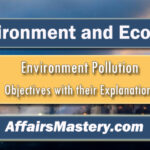Set 5 | Important Ecology MCQs
Important Ecology MCQs. Ecology plays a crucial role within the broader field of environment and ecology. It serves as a foundational concept for achieving success in competitive exams such as Civil Services, State exams, SSC, Railways, Banking, and more. Mastering these subjects offers a unique advantage, allowing you to gain invaluable insights into the country’s environmental legacy. With a focus on Environment, Biodiversity, and Ecology, this knowledge not only sharpens your competitive edge but also equips you to excel in these challenging exams.
| MCQs on Ecology – Objective Questions and Answers |

Q41. The transitional zone between two distinct communities is known as: (U.P.P.C.S.(Pre) 2012)
[A] Ecotype
[B] Arcade
[C] Ecosphere
[D] Ecotone
View Explanation
Correct Answer is D.
- An ecotone is indeed a region where two distinct ecosystems or biological communities meet and integrate. These transition zones are often characterized by greater biodiversity because they include species from both ecosystems, along with some unique to the ecotone itself.
- Ecotones can occur naturally, such as between a forest and grassland, or between aquatic and terrestrial environments like a wetland, and they play a crucial role in ecological balance and habitat diversity.

Q42. Which of the following is the most stable ecosystem? (U.P.P.C.S. (Pre) 2013)
[A] Desert
[B] Mountain
[C] Ocean
[D] Forest
View Explanation
Correct Answer is C.
- Oceans are the birthplace of life on Earth and host the greatest biodiversity. No land-based ecosystem can rival the biological richness of coral reefs, both in terms of species diversity and the unique survival strategies found there.

Q43. Most stable Ecosystem is – (R.A.S./R.T.S. (Pre) 2008)
[A] Forest
[B] Grassland
[C] Desert
[D] Ocean
View Explanation
Correct Answer is D.
- The most stable ecosystem is generally considered to be the ocean. Oceans have a large buffer capacity, immense biodiversity, and vast resources, which help maintain balance and stability over long periods.
- Coral reefs, despite being sensitive to environmental changes, also represent stable ecosystems due to their complex and resilient food webs.
- Additionally, tropical rainforests are sometimes regarded as stable ecosystems because of their high biodiversity and the intricate relationships between species.

Q44. Which is the most stable ecosystem? (U.P. P.C.S. (Pre) 2018)
[A] Marine (ocean)
[B] Forest
[C] Mountain
[D] Desert
View Explanation
Correct Answer is A.
- The ocean is widely regarded as the most stable ecosystem due to its immense buffering capacity, rich biodiversity, and abundant resources, which help sustain balance over time.
- Coral reefs, though sensitive to changes, are also seen as stable due to their complex and resilient food chains. Similarly, tropical rainforests are often considered stable ecosystems because of their high species diversity and intricate interspecies relationships.

Q45. Which of the following is an example of anthropogenic biome? (U.P. P.C.S. (Pre) 2018)
[A] Fresh water
[B] Grassland
[C] Rain forest
[D] Cropland
View Explanation
Correct Answer is D.
- Freshwater, grasslands, and rainforests are examples of natural biomes, while croplands represent an anthropogenic biome shaped by human activity.

Q46. Consider the following statements: (I.A.S. (Pre) 2018)
- Most of the world’s coral reefs are in tropical waters.
- More than one-third of the world’s coral reefs are located in the territories of Australia, Indonesia and the Philippines.
- Coral reefs host far more number of animal phyla than those hosted by tropical rainforests. Which of the statements given above is/are correct?
[A] 1 and 2 only
[B] 3 only
[C] 1 and 3 only
[D] 1, 2 and 3
View Explanation
Correct Answer is D.
- Corals are invertebrate animals, and hard corals are responsible for building reefs by secreting skeletons that form massive structures, such as Australia’s Great Barrier Reef.
- Most coral reefs are found in tropical oceans near the equator, with over one-third located in Australia, Indonesia, and the Philippines. Coral reefs rank among the planet’s most diverse ecosystems.
- Although they cover less than 1% of the ocean floor, they support more than 25% of all known marine fish species. Coral reefs host 32 of the 34 recognized animal phyla, compared to only 9 in tropical rainforests.

Q47. Which one of the following is the largest ecosystem of the earth? (U.P. R.O./A.R.O. (Pre) 2017)
[A] Hydrosphere
[B] Biome
[C] Lithosphere
[D] Biosphere
View Explanation
Correct Answer is D.
- The biosphere is the Earth’s largest ecosystem, encompassing all regions where life exists. It is a complex and interconnected zone that includes the atmosphere (air), hydrosphere (water), and lithosphere (land), forming a thin layer around the Earth’s surface.
- However, the biosphere is absent in extreme environments such as the North and South Poles, the highest mountain peaks, and the deepest parts of the oceans.
Q48. The cycling of elements in an ecosystem is called: (U.P.P.C.S.(Pre) 2012)
[A] Chemical cycles
[B] Biogeochemical cycles
[C] Geological cycles
[D] Geochemical cycles
View Explanation
Correct Answer is B.
- In Earth science, a biogeochemical cycle refers to the process through which a chemical substance moves between the living (biotic) and non-living (abiotic) components of the Earth. Natural examples of biogeochemical cycles include those of nitrogen, phosphorus, and carbon.

Q49. In case of which one of the following biogeochemial cycles, the weathering of rocks is the main source of release of nutrient to entry the cycle? (I.A.S (Pre) 2021)
[A] Carbon cycle
[B] Nitrogen cycle
[C] Phosphorus cycle
[D] Sulphur cycle
View Explanation
Correct Answer is C.
- Phosphorus is a chemical element found on Earth in various compound forms, such as the phosphate ion (PO₄³⁻), present in water, soil, and sediments.
- A significant amount of phosphorus is stored in rocks and sedimentary deposits, from which it is released through weathering, leaching, and mining. It moves through freshwater and terrestrial ecosystems via plants, herbivores, predators, and parasites, eventually returning to these ecosystems through death and decay.
- However, much of it is deposited in marine environments, where it circulates in shallow sediments or resides in deep ocean sediments, surfacing only occasionally. Phosphorus is returned to land through fish harvesting and the collection of guano from seabirds.
Q50. The movement of nutrient elements through various components of an ecosystem is called: (U.P.P.C.S. (Pre) 2020)
[A] Bio-geo-chemical cycle
[B] Bio-geological cycle
[C] Ecological succession
[D] Biological cycle
View Explanation
Correct Answer is A.
- The movement of nutrient elements through various components of an ecosystem is called a biogeochemical cycle.





